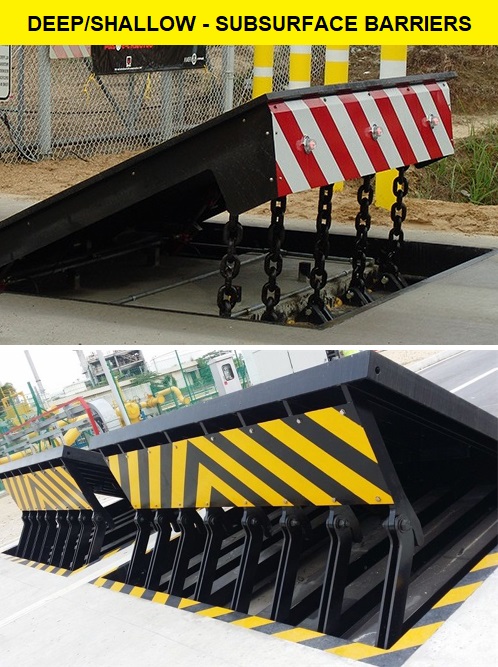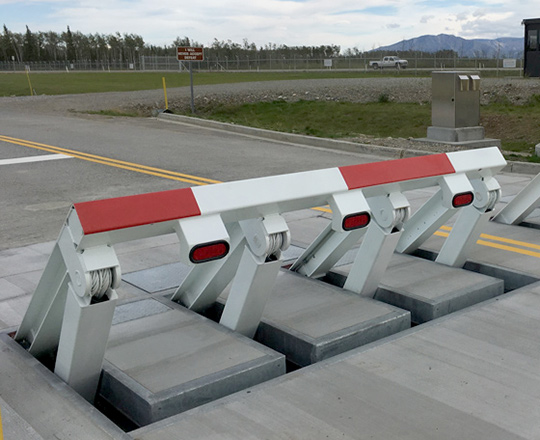The 5-Second Trick For Wedge Barriers
Wiki Article
The Only Guide for Wedge Barriers
Table of ContentsThe Of Wedge BarriersWedge Barriers Can Be Fun For Anyone


The springtime rod 58 is combined to a web cam(e. g., camera 80 received FIG. 4) of the lifting mechanism 50. The springs 60 disposed concerning the spring pole 58 are kept in compression by springtime supports 62, including a dealt with springtime support 64. That is, the set spring support 64 is repaired about the structure 14 et cetera of the bather 10.
Wedge Barriers Fundamentals Explained
The remaining force applied to the cam web cam deploy release wedge plate 16 may be provided by an electromechanical actuator 84 or other actuator. The springtime setting up 54 and the actuator 84(e. Wedge Barriers. g., electromechanical actuator)might operate with each other to translate the web cam and raise the wedge plate 16.
As discussed over, the spring assembly 54 puts in a consistent force on the web cam, while the electromechanical actuator might be controlled to exert a variable force on the camera, therefore allowing the lifting and lowering( i. e., releasing and withdrawing )of the wedge plate 16. In particular personifications, the continuous pressure applied by the springtime assembly 54 might be flexible. g., electromechanical actuator) is disabled. As will be valued, the springtime setting up 54 might be covered and protected from particles or other components by a cover plate(e. g., cover plate 68 received FIG. 4) that may be considerably flush with the elevated surface area 38 of the structure 14. As discussed over, in the deployed position, the wedge plate 16 offers to obstruct accessibility or traveling past the obstacle 10. The obstacle 10(e. g., the wedge plate 16 )might obstruct pedestrians or automobiles from accessing a building or pathway. As talked about over, the obstacle 10 is connected to the support 30 safeguarded within the structure 14,

front brackets 71. Because of this, the affiliation assemblies 72 might pivot and rotate to allow the collapse and expansion of the link settings up 72 during retraction and deployment of the bather 10. The affiliation assemblies 72 cause activity of the wedge plate 16 to be restricted. For instance, if a vehicle is taking a trip towards the released wedge plate 16(e. For instance, in one situation, the safety and security legs 86 might be expanded throughoutmaintenance of the obstacle 10. When the safety legs 86 are released, the security legs 86 support the weight of the wedge plate 16 against the surface 12. Because of this, the lifting mechanism 50 might be deactivated, serviced, gotten rid of, changed, and so forth. FIG. 5 is partial viewpoint sight of a personification of the surface-mounted wedge-style obstacle 10, illustrating the webcam 80 and the cam surfaces 82 of the lifting system 50. Particularly, 2 webcam surfaces 82, which are described as lower cam surfaces 83, are placed below the webcam 80. The reduced web cam surface areas 83 might be dealt with to the surface 12 (e. For example, the lower webcam surfaces 83 and the mounting plate 85 may create a single item that is protected to the anchor 30 by bolts or other mechanical bolts. In addition, 2 camera surface areas 82, which are described as upper web cam surfaces 87, are positioned above the cam 80 and coupled to (e. In other embodiments, interfering layers or plates might be positioned in between the surface area 12 and the reduced camera surfaces 83 and/or the wedge plate 16 and the top camera surface areas 87 As mentioned over, the camera 80 converts along the web cam surface areas 82 when the wedge plate 16 is raised from the retracted placement to the released setting. Additionally, as discussed over, the spring setting up 54 (see FIG. 3 )may supply a force acting on the cam 80 in the instructions 102 via springtime rod 58, which might lower the force the electromechanical actuator 84 is needed to put on the web cam 80 in order to actuate and raise the wedge More Bonuses plate 16. 1 )to the released placement(see FIG. 4). As revealed, the web cam 80 includes track wheels Visit Website 104(e. g., rollers), which get in touch with and convert along the cam surface areas 82 during procedure.
Report this wiki page